
AMD’s Radeon RX 7900 GRE was an unexpected product. Initially a China-only SKU, the GRE (Golden Rabbit Edition) is now available globally to DIYers. It features a partially disabled Navi 31 die with a modular memory subsystem. The Graphics Compute Die (GCD) is surrounded by six Memory Complex Dies (MCD), each packing a memory controller and part of the 64 MB L3 cache buffer. The Radeon RX 7900 GRE is fed by two 8-pin power connectors and mainly uses a dual-slot, triple-fan design.
AMD Radeon RX 7900 GRE Specifications and Pricing

The AMD Radeon RX 7900 GRE offers 5120 shaders (stream processors) across 80 Compute Units. The GPU is coupled with a 256-bit bus (64-bit x4) and backed by 64MB (16MB x4) of L3 cache. The shader cores are clocked at a base clock of 1,287 MHz with a boost clock of 2,245 MHz. The 16GB GDDR6 memory buffer is clocked at 18 Gbps.
| GPU | Nvidia RTX 4070 Super | NVIDIA RTX 4070 | AMD Radeon RX 7800 XT | AMD Radeon RX 7900 GRE |
|---|---|---|---|---|
| GPU Die | AD104 | GA104 | Navi 32 | Navi 31 |
| SMs | 56 | 46 | 60 | 80 |
| Cores | 7,186 | 5,888 | 3,840 | 5,120 |
| Texture Units | 224 | 184 | 240 | 320 |
| ROPs | 80 | 64 | 96 | 160 |
| RT Cores | 56 | 46 | 60 | 80 |
| Base clock | 1,980 MHz | 1,920 MHz | 1,295 MHz | 1,287 MHz |
| Boost clock | 2,475 MHz | 2,475 MHz | 2,430 MHz | 2,245 MHz |
| Bus Width | 192-bit | 192-bit | 256-bit | 256-bit |
| Bandwidth | 504 GB/s | 504 GB/s | 624 GB/s | 576 GB/s |
| Memory | 12 GB GDDR6 | 12 GB GDDR6X | 16 GB GDDR6 | 16 GB GDDR6 |
| Memory Clocks | 21 Gbps | 21 Gbps | 19.5 Gbps | 18 Gbps |
| TBP | 220W | 200W | 263W | 260W |
| LL Cache | 48 MB L2 | 36 MB L2 | 64 MB L3 | 64 MB L3 |
| Price (Newegg) | $479 | $439 | $489 | $549 |
The 7900 GRE has a TBP (Total Board Power) of 260W and currently retails at $549 and above. While it features more cores than the 7800 XT (5,120 vs. 3,840), it has a lower memory bandwidth of 576 GB/s (vs. 624 GB/s) because of slower graphics memory.
Test Bench

- Motherboard: ASUS Z790 Maximus Hero.
- CPU: Intel Core i9-13900K.
- Cooler: Lian Li Galahad 360 AIO.
- Memory: 16GB x2 DDR5-6000 CL30.
- Power Supply: Corsair RM1000e.
Gaming Benchmarks: 1080p Performance
Full HD or 1080p is still the most popular resolution among gamers, accounting for 58% of Steam users. The Radeon RX 7900 GRE is the fastest midrange GPU, beating the RTX 4070, 4070 Super, and the RX 7800 XT at 1080p. Exceptions include “A Plague Tale: Requiem,” “Avatar: Frontiers of Pandora,” and “Dying Light 2” where the RTX 4070 Super comes out on top.



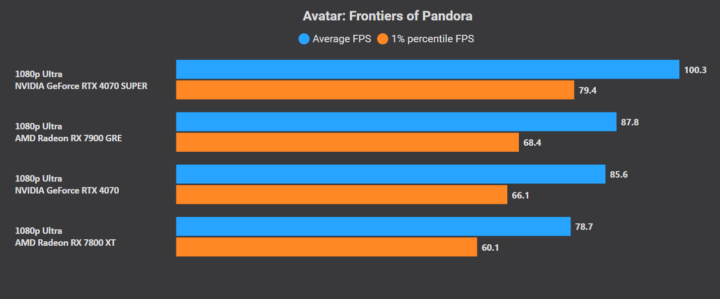



Cyberpunk 2077 and Hogwarts Legacy favor the RX 7800 XT, likely due to its higher memory bandwidth.



On average, the RX 7900 GRE is 5-6% faster than the RX 7800 XT and the GeForce RTX 4070 Super at 1080p.
Gaming Benchmarks: 1440p Performance
QHD or 1440p increases the pixel count to 4 billion. The Radeon RX 7900 GRE maintains its position at the top of the chart, but the RTX 4070 Super erases much of the deficit.




The GeForce RTX 4070 Super is 4-5% faster than the RX 7900 GRE in three titles, including Avatar: Frontiers, Dying Light 2, and Assassin’s Creed Mirage.





The Radeon RX 7900 GRE outperforms the competition in the remaining six titles, but its lead over the RTX 4070 Super drops to a mere 1.4 FPS at 1440p.

Gaming Benchmarks: 4K Performance
Ultra HD (4K) increases the pixel count to over 8 billion. This increases the strain on the memory bus, making wider configurations more suited for this resolution. The Radeon RX 7900 GRE is about as fast as the GeForce RTX 4070 Super at 4K.

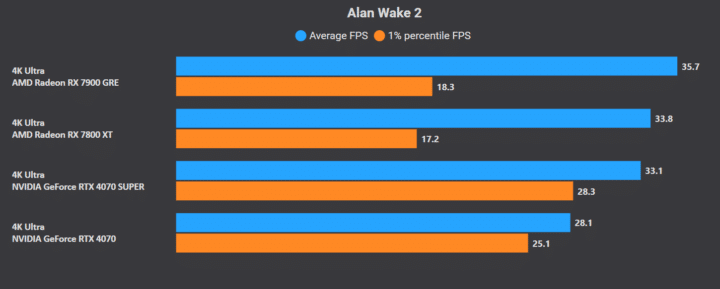

The RTX 4070 Super continues to deliver superior performance in AC: Mirage, Plague Tale, Avatar: Frontiers, and Dying Light 2. Additionally, Robocop joins the list of GeForce-favored titles.

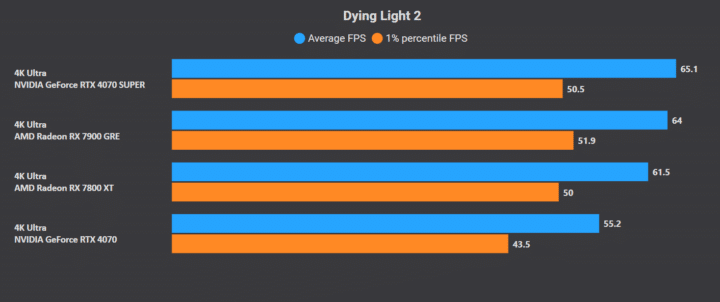




On average, the RX 7900 GRE is 1% faster than the RTX 4070 Super at 4K, leading the RX 7800 XT by 7%. These cards aren’t meant for 4K, but with some upscaling, they shouldn’t have much trouble pumping out several hundred billion pixels a second.

Gaming Benchmarks: Ray Tracing Performance
AMD accelerates ray tracing via the dedicated “Ray Accelerator,” a modified Texture Unit capable of intersection tests. RDNA 3 leverages BVH4, a four-wide format capable of processing four triangles or box structures. The SIMD units (stream processors) handle the ray traversal, unlike NVIDIA’s solution where the entire process is offloaded to the RTCores.
NVIDIA’s RTX cards offer considerable improvements over their Radeon counterparts in ray-traced workloads. The RTX 4070 is notably faster than the RX 7900 GRE in 6 out of 8 games, while the 4070 Super loses in just one title.



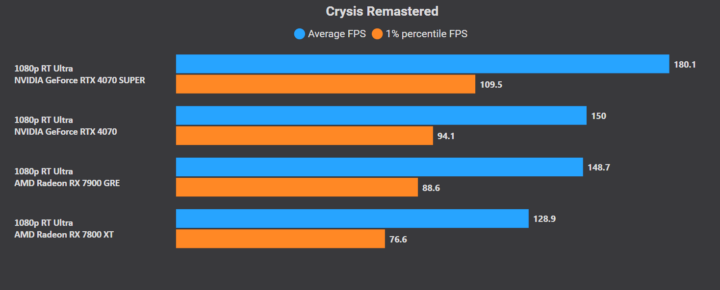




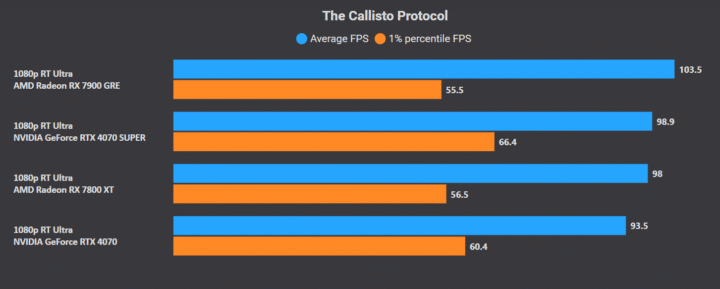
The Callisto Protocol is the only game where the Radeon RX 7900 GRE can claim a win, and even then delivers worse lows.

On average, the GeForce RTX 4070 Super is 25% faster than the 7900 GRE in ray-traced gaming. Even the RTX 4070 which costs less than $450 holds a 7% lead over the GRE.
Core Frequencies and Overclocking
We overclocked the RX 7900 GRE’s GPU core by +350 MHz but didn’t get any noteworthy gains. This should have increased the boost clock from ~2.25GHz to 2.60GHz, but the clocks didn’t even hit 2.4 GHz.

This was even after increasing the power limit by 19%. This increased the in-game board power to 296W (from 260W), but the frame rates remained the same.
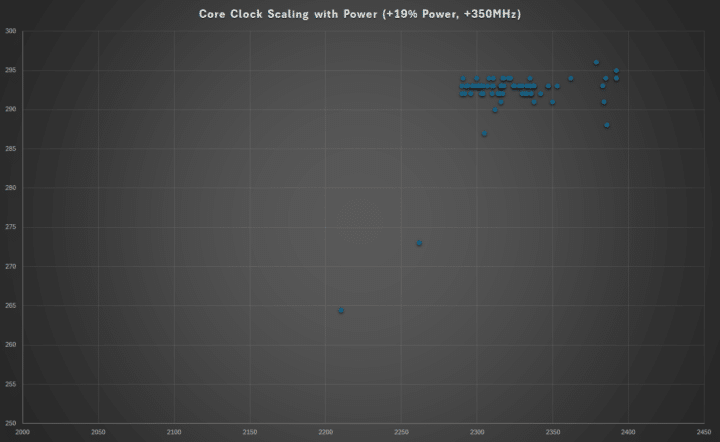
Performance Per Watt and Power Consumption
The Radeon RX 7900 GRE has an average power consumption of 255W, 37W higher than the RTX 4070 Super and within close range of the 7800 XT.

Factoring in the framerates, it’s clear that the RTX 4070 and 4070 Super are considerably more power-efficient than the RX 7900 GRE. The case only worsens with ray tracing where the 4070 Super delivers 45% more frames-per-watt than the 7900 GRE.
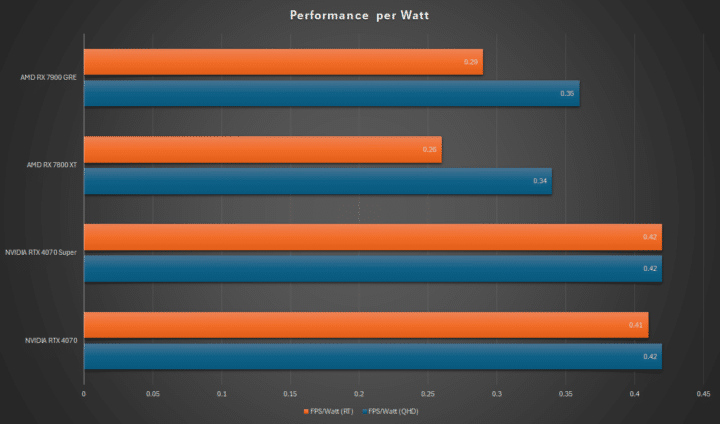
Performance Per Dollar and Conclusion
The Radeon RX 7900 GRE excels in the price-performance department. In rasterized games, it offers the highest performance per dollar, followed by the RX 7800 XT and the RTX 4070 Super. Ray tracing remains a weak spot, but that’s not a priority for much of the PC gaming audience. Overall, the Radeon RX 7900 GRE is a highly recommended graphics card.

Pros and Cons

+ Solid rasterization performance.
+ High performance per dollar.
+ Large memory buffer (16GB).
– Mediocre ray tracing performance.
– Power efficiency could be better.
– Pricier than the RTX 4070 Super.





